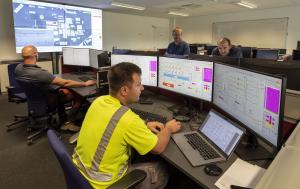Re-centralization has started
A network of temporary control rooms was set up to support commissioning and operation of systems before the main control room became available. Teams are now working to re-centralize some of the distributed functions.
Staged integration and commissioning started at the electrical substation, then moved to the cooling water and heat rejection area at the opposite end of the platform. To network the temporary control rooms in each of these areas, I&C experts installed temporary fibre connections to the Headquarters building, where the technical infrastructure and the temporary main control room (T-MCR) are hosted while the Control Building is being readied. The result was two separate network legs.
Just over a year ago, a big improvement was made by connecting the two legs to one another to provide resilience. In large building projects, cables are at risk of being cut by accident; the connection between the two legs provides an alternative path over which data can be transmitted in the case of failure along one leg.
"We are now at a point where we can simplify the architecture and prepare for a more centralized control system by taking back some of the functions that were distributed to the temporary control rooms," says Bertrand Bauvir, leader of ITER's Central Control Integration Section. "We started at the end of last year."
Work is now underway to decommission the temporary control rooms and migrate the functionality to a central location—first to the T-MCR and then, in 2024, to the ITER Control Building, where they will reside for the lifetime of ITER. But select temporary control rooms are expected to maintain a vital role for about two more years.
The human-machine interface remains the same
The same human-machine interface that was used in each of the temporary control rooms has been re-implemented in the T-MCR and will remain unchanged when moved to its ultimate home in the ITER Control Room. The operator terminals are also configured in the same way in each of the three settings; however, access control may be different.
"We have both role-based and condition-based access control," says Bauvir. "For example, not everybody is licensed to operate 400 kilovolt equipment connected to the French grid. Role-based access control means only a subset of the users of the control system—those who are licensed to operate a part of the machine—can have access."
"A good example of condition-based access control is the cryoplant, which is currently in commissioning by a number of different teams. We restricted the operability of the cryoplant equipment to just the temporary control room in that building. You can connect from any other control room, and you could monitor and observe any of the measurement points from anywhere in the current plant, but you could not take operational control."
Eventually, all operations will be performed centrally from the ITER Control Building. But as ITER is now in staged commissioning, which describes the parallel commissioning of different plant systems by different groups, select temporary control rooms still have an essential role in allowing different teams to work independently and operate very close to the equipment in question.


